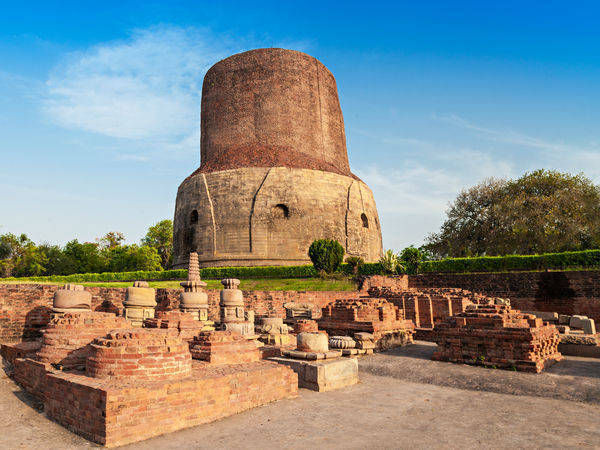Chinese, Indian archaeologists mull exploring birthplace of Buddhism
Updated: 2016-05-24 14:44
(Xinhua)
|
||||||||
 |
|
Dhamek Stupa at Sarnath. [Photo/CRI/travel.india.com] |
The Institute of Archaeology under the Chinese Academy of Social Sciences will collaborate with Indian archaeologists at key sites in Sarnath, India. The project is expected to include excavations, cultural relics protection, and safety monitoring and control, Wang Wei, director of the institute, told Xinhua Monday.
Sarnath, in Northeast India, is where Buddha gave his first sermon and is considered one of the most important holy sites by Buddhists.
"We are very excited because our archaeologists will be finally able to look for, and may later touch and protect Indian relics that they have only seen in books," said Wang.
Sanjay Kumar Manjul, director of the Institute of Archaeology under the Archaeological Survey of India, voiced strong support for the project, which is expected to begin in November and last until 2020.
Another project, focusing on relics at Rakhigarhi, west of New Delhi, the site of one of the largest Indus Valley Civilization settlements, will also be launched.
"We are two neighbors with a long history of cultural, spiritual and economic ties, and I believe this project will strengthen our connection," he said.
The director explained that during the first millennium, many Chinese scholars and monks traveled to India, including Xuan Zang and Yi Jing, who attended Nalanda University in Bihar, north India.
"The detailed accounts of their journeys are an important resource for historians, archaeologists, Buddhologists and those interested in studying cross-cultural interactions in the pre-modern world. On the basis of these records, archaeologists have explored several Buddhist sites in India," he said.
Indian archaeologists have been excavating at Sarnath since the late 19th century, and a considerable number of temple relics and statues have been discovered. However, they have yet to be dated.
Another mystery Wang is interested in is the connection between Buddha statues from the Gupta Dynasty, discovered in Sarnath, and similar items made in China during the Beiqi Dynasty (550-577).
"The relationship between these relics may tell us something new about the spread of Buddhism in China," said Wang.
The project will feature some of the world's leading archeological technology, including three-dimensional remote sensing and three-dimensional imaging systems, as well as advanced indoor testing and analysis techniques, said Wang.
Related:
- Wildfires continue to rage in Russia's Far East
- Eiffel Tower to become rental apartment for first time
- US lifts arms embargo on Vietnam
- At least 17 schoolgirls killed in boarding-house fire in N Thailand
- Russia to build first cruise liner in 60 years
- LinkedIn, Airbnb match refugees with jobs, disaster survivors with rooms

 Stars of Lijiang River: Elderly brothers with white beards
Stars of Lijiang River: Elderly brothers with white beards
 Wealthy Chinese children paying money to learn British manners
Wealthy Chinese children paying money to learn British manners
 Military-style wedding: Fighter jets, grooms in dashing uniforms
Military-style wedding: Fighter jets, grooms in dashing uniforms
 Striking photos around the world: May 16 - May 22
Striking photos around the world: May 16 - May 22
 Robots help elderly in nursing home in east China
Robots help elderly in nursing home in east China
 Hanging in the air: Chongqing holds rescue drill
Hanging in the air: Chongqing holds rescue drill
 2.1-ton tofu finishes in two hours in central China
2.1-ton tofu finishes in two hours in central China
 Six things you may not know about Grain Buds
Six things you may not know about Grain Buds
Most Viewed
Editor's Picks

|

|

|

|

|

|
Today's Top News
Liang avoids jail in shooting death
China's finance minister addresses ratings downgrade
Duke alumni visit Chinese Embassy
Marriott unlikely to top Anbang offer for Starwood: Observers
Chinese biopharma debuts on Nasdaq
What ends Jeb Bush's White House hopes
Investigation for Nicolas's campaign
Will US-ASEAN meeting be good for region?
US Weekly

|

|







